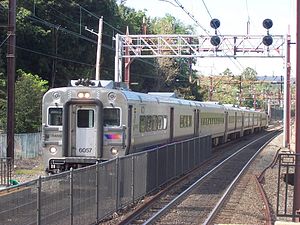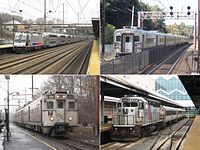
A diesel multiple unit or DMU is a multiple-unit train powered by on-board diesel engines. A DMU requires no separate locomotive, as the engines are incorporated into one or more of the carriages. Diesel-powered single-unit railcars are also generally classed as DMUs. Diesel-powered units may be further classified by their transmission type: diesel–mechanical DMMU, diesel–hydraulic DHMU, or diesel–electric DEMU.

A bilevel car or double-decker coach is a type of rail car that has two levels of passenger accommodation as opposed to one, increasing passenger capacity.
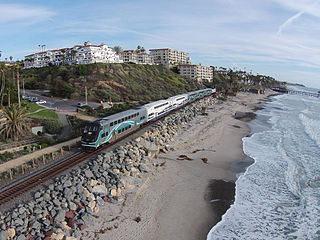
Metrolink is a commuter rail system in Southern California, serving Los Angeles, Orange, Riverside, San Bernardino, and Ventura counties, as well as to Oceanside in San Diego County. The system consists of eight lines and 69 stations operating on 545.6 miles (878.1 km) of track. Arrow is operated under a contract with the San Bernardino County Transportation Authority (SBCTA).

The San Joaquins is a passenger train service operated by Amtrak in California's San Joaquin Valley. Six daily round trips run between its southern terminus at Bakersfield and Stockton, with onward service to Sacramento and Oakland.
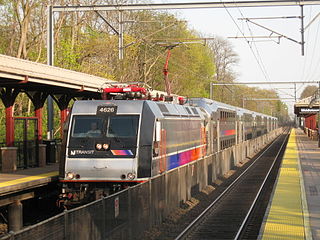
The North Jersey Coast Line is a commuter rail line running from Rahway to Bay Head, New Jersey, traversing through the Jersey Shore region. Operated by New Jersey Transit, the line is electrified as far south as Long Branch. On rail system maps it is colored light blue, and its symbol is a sailboat. The line runs along the former New York & Long Branch Railroad, which was co-owned by the Central Railroad of New Jersey and the Pennsylvania Railroad.

Amtrak California is a brand name used by the California Department of Transportation (Caltrans) Division of Rail for three state-supported Amtrak regional rail routes in California – the Capitol Corridor, the Pacific Surfliner, and the San Joaquins – and their associated connecting network of Amtrak Thruway transportation services.

Commuter rail services in the United States, Canada, Cuba, Mexico, Panama, and Costa Rica provide common carrier passenger transportation along railway tracks, with scheduled service on fixed routes on a non-reservation basis, primarily for short-distance (local) travel between a central business district and adjacent suburbs and regional travel between cities of a conurbation. It does not include rapid transit or light rail service.

The BiLevel Coach is a bilevel passenger railcar currently built by Alstom and previously by Bombardier, Hawker Siddeley Canada, the Canadian Car and Foundry, and the UTDC. Used by North American commuter rail operators, they hold 360 passengers and feature a distinctive octagonal profile.

The Atlantic City Line (ACL) is a commuter rail line operated by NJ Transit (NJT) in the United States between Philadelphia, Pennsylvania and Atlantic City, New Jersey, operating along the corridor of the White Horse Pike. It runs over trackage that was controlled by both the Pennsylvania Railroad (PRR) and the Pennsylvania-Reading Seashore Lines. It shares trackage with SEPTA and Amtrak on the Northeast Corridor (NEC) until it crosses the Delaware River on Conrails Delair Bridge into New Jersey.
Push–pull is a configuration for locomotive-hauled trains, allowing them to be driven from either end of the train, whether having a locomotive at each end or not.
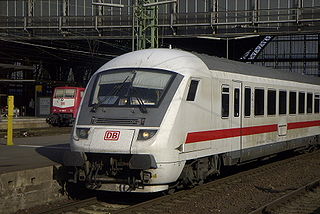
A control car, cab car, control trailer, or driving trailer is a non-powered rail vehicle from which a train can be operated. As dedicated vehicles or regular passenger cars, they have one or two driver compartments with all the controls and gauges required to remotely operate the locomotive, including exterior locomotive equipment such as horns, bells, ploughs, and lights. They also have communications and safety systems such as GSM-R or European Train Control System (ETCS). Control cars enable push-pull operation when located on the end of a train opposite its locomotive by allowing the train to reverse direction at a terminus without moving the locomotive or turning the train around.

The Comet V railcar is the fifth generation of the Comet railcar series. Produced by the manufacturer Alstom, the Comet V is a rather different car compared to previous models in the series. The Comet V has been in use by New York metropolitan area commuter rail operators New Jersey Transit and Metro-North since April 2002.

Shoreliners are a class of locomotive-hauled rail car used by the Metro-North Railroad. They are similar to the Comet coaches used by New Jersey Transit. Ownership of the fleet is split between the Metropolitan Transportation Authority (MTA) and the Connecticut Department of Transportation, as part of the latter's operating agreement with the MTA. MTA coaches have blue window bands, while CTDOT coaches have red ones. Many of the Shoreliner cars are named in honor of people and places significant to their service area, such as The Connecticut Yankee and Washington Irving.
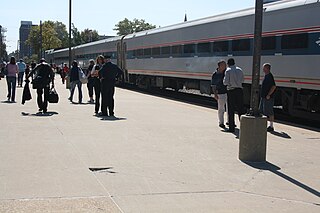
The Horizon is a type of single-level intercity railroad passenger car used by Amtrak, the national rail passenger carrier in the United States. Amtrak ordered the cars to supplement their existing fleet of Amfleet I single-level cars used on shorter distance corridor trains. The design was based on the Comet railcar used for commuter railroads, but with modifications to make them more suitable for intercity service. Bombardier Transportation built 104 cars from 1988 to 1990 in two basic types: coaches and food service (café) cars.

The MultiLevel Coach is a bi-level passenger rail car for use on commuter rail lines. Originally built by Bombardier Transportation beginning in 2006, they are now built by Alstom since 2021, who markets the coaches as part of their Adessia Coach series.

The Jersey Arrow is a type of electric multiple unit (EMU) railcar developed for the Pennsylvania Railroad, and used through successive commuter operators in New Jersey, through to NJ Transit. Three models were built, but only the third model is in use today. The series is similar to SEPTA's Silverliner series, but include center doors among other differences in details.

The California Car is the first generation of intercity railcars owned by the California Department of Transportation (Caltrans) and operated by Amtrak under the Amtrak California brand on intercity corridor routes in Northern and Central California. The cars were built in the mid-1990s for the Caltrans Division of Rail by Morrison–Knudsen and the American Passenger Rail Car Company (Amerail). The cars are similar in exterior dimensions to Amtrak's Superliner, but original in design to provide rolling stock suitable for California intercity services up to six hours, with more frequent stops than most other Amtrak routes. All cars were overhauled by Alstom at its Mare Island facility between 2009 and 2012.

Metrolink, the commuter rail system serving Southern California, operates a fleet of passenger train rolling stock consisting of 60 locomotives, 137 active Bombardier BiLevel Coaches, and 137 Rotem Commuter Cars. Operation of the weekday train schedule requires 36 locomotives to be operational.

Siemens Venture is a type of locomotive-hauled passenger railroad car built by Siemens Mobility for the North American market. The cars are derived from the Siemens Viaggio Comfort cars used in Europe, with adaptations for North American operations. The cars entered service with Brightline in 2018 and with Amtrak Midwest in 2022. They have also been ordered by Amtrak for national and other state-supported routes, Via Rail, and Ontario Northland. The Venture cars will also be used on Amtrak’s Airo trainsets.
